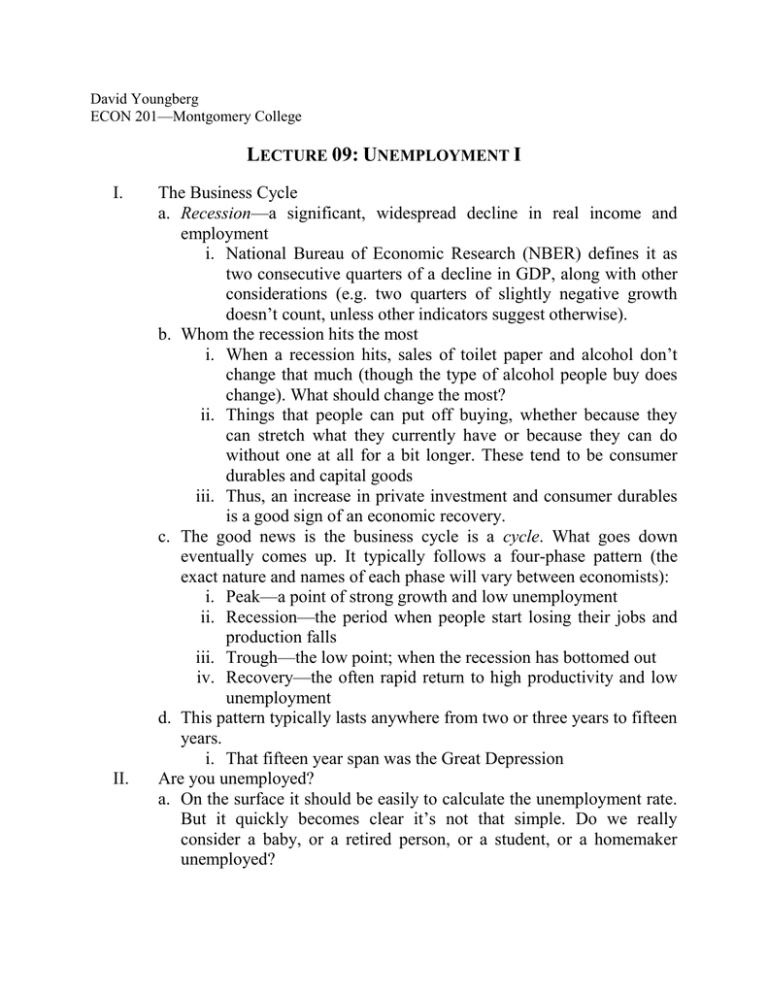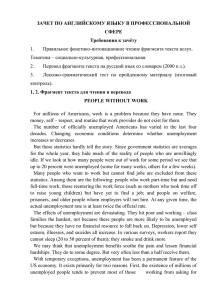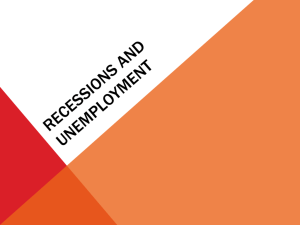10/01 - David Youngberg
advertisement

David Youngberg ECON 201—Montgomery College LECTURE 09: UNEMPLOYMENT I I. II. The Business Cycle a. Recession—a significant, widespread decline in real income and employment i. National Bureau of Economic Research (NBER) defines it as two consecutive quarters of a decline in GDP, along with other considerations (e.g. two quarters of slightly negative growth doesn’t count, unless other indicators suggest otherwise). b. Whom the recession hits the most i. When a recession hits, sales of toilet paper and alcohol don’t change that much (though the type of alcohol people buy does change). What should change the most? ii. Things that people can put off buying, whether because they can stretch what they currently have or because they can do without one at all for a bit longer. These tend to be consumer durables and capital goods iii. Thus, an increase in private investment and consumer durables is a good sign of an economic recovery. c. The good news is the business cycle is a cycle. What goes down eventually comes up. It typically follows a four-phase pattern (the exact nature and names of each phase will vary between economists): i. Peak—a point of strong growth and low unemployment ii. Recession—the period when people start losing their jobs and production falls iii. Trough—the low point; when the recession has bottomed out iv. Recovery—the often rapid return to high productivity and low unemployment d. This pattern typically lasts anywhere from two or three years to fifteen years. i. That fifteen year span was the Great Depression Are you unemployed? a. On the surface it should be easily to calculate the unemployment rate. But it quickly becomes clear it’s not that simple. Do we really consider a baby, or a retired person, or a student, or a homemaker unemployed? b. We defined the unemployed as adult (16 years and older) workers who do not have a job but are willing to work, able to work, and actively looking for work. Combine them with the employed (those with full or part time jobs) and you have the labor force. 𝑈𝑛𝑒𝑚𝑝𝑙𝑜𝑦𝑚𝑒𝑛𝑡 = 𝑈𝑛𝑒𝑚𝑝𝑙𝑜𝑦𝑒𝑑 × 100 𝑈𝑛𝑒𝑚𝑝𝑙𝑜𝑦𝑒𝑑 + 𝐸𝑚𝑝𝑙𝑜𝑦𝑒𝑑 𝑈𝑛𝑒𝑚𝑝𝑙𝑜𝑦𝑚𝑒𝑛𝑡 = 𝑈𝑛𝑒𝑚𝑝𝑙𝑜𝑦𝑒𝑑 × 100 𝐿𝑎𝑏𝑜𝑟 𝐹𝑜𝑟𝑐𝑒 i. Thus the unemployment rate does not consider people in prison. When an unemployed person goes to jail, the unemployment rate goes down! c. The unemployment rate is a little suspicious because it doesn’t include discouraged workers—workers who have given up looking for work but who would still like a job. i. But including such workers is tricky because discouragement is a spectrum. How discouraged are you? Should you include workers who became so discouraged, they went back to school? ii. Thankfully, the good folks at BLS calculate unemployment in different ways (all values are as a percent):1 Measure Seasonally Adjusted Jan. 2014 Jan. 2015 U-1 Persons unemployed 15 weeks or longer, as a percent of the civilian labor force 3.4 2.7 U-2 Job losers and persons who completed temporary jobs, as a percent of the civilian labor force 3.5 2.7 U-3 Total unemployed, as a percent of the civilian labor force (official unemployment rate) 6.6 5.7 U-4 Total unemployed plus discouraged workers, as a percent of the civilian labor force plus discouraged workers 7.1 6.1 U-5 Total unemployed, plus discouraged workers, plus all other persons marginally attached to the labor force, as a percent of the civilian labor force plus all persons marginally attached to the labor force 8.1 7.0 U-6 Total unemployed, plus all persons marginally attached to the labor force, plus total employed part time for economic reasons, as a percent of the civilian labor force plus all persons marginally attached to the labor force 12.7 11.3 NOTE: Persons marginally attached to the labor force are those who currently are neither working nor looking for work but indicate that they want and are available for a job and have looked for work sometime in the past 12 months. Discouraged workers, a subset of the marginally attached, have given a job-market related reason for not currently looking for work. Persons employed part time for economic reasons are those who want and are available for full-time work but have had to settle for a part-time schedule. Updated population controls are introduced annually with the release of January data. 1 http://www.bls.gov/news.release/empsit.t15.htm III. 2 3 Types a. Frictional—this is unemployment that derives from people between jobs. Even when the economy is strong, it takes time for individuals who are changing jobs or for new entrants in the workforce to find their first job. At least some degree of fictional unemployment is inevitable. i. Frictional unemployment occurs because it takes time to match employers with employees. Anything that makes this matching easier or more difficult changes frictional unemployment. For example, the internet makes it easier for a firm to find the right match; frictional unemployment is lower. ii. The optimal level of unemployment is thus not 0%. A very low unemployment rate suggests an undesirable level of rigidity. iii. Most of U.S. employment is short term, suggesting that it’s frictional. In 2005, 65.5% of the unemployed were unemployed fourteen weeks or less (and 35.1% were unemployed less than five weeks). iv. The high unemployment rate of recent years is unusual.2 b. Structural—related to frictional unemployment, this kind of unemployment describes workers who are unemployed persistently and for a long period of time. i. Sometimes this involves a skill mismatch: a new technology might transform what employers want but it takes time for workers to cultivate those skills. ii. It can also involve a geographic mismatch: the oil boom in North Dakota led to a labor shortage because so few people lived in the state.3 iii. Labor regulations can also cause this sort of long-term unemployment. Well-meaning laws can pervert incentives. Unemployment benefits functionally pay people to not work. Minimum wage laws decrease the demand for labor. http://www.bls.gov/news.release/empsit.t12.htm For more information, see ismyjobinanotherstate.com Regulations on whom and how you can fire make firms hesitant to hire in the first place. c. Cyclical—this type of unemployment originates from declines in the business cycle and is typically what people think of when they hear “unemployment.” It occurs when many businesses across many sectors cannot justify hiring people due to low demand for their goods or services. i. The cyclically unemployed are unemployed not because they are undesirable workers or because they haven’t put in enough time to find a job. ii. However, some economists point out there’s a supply solution to this problem (rather than just increasing aggregate demand). Unemployed workers should be willing to accept a lower wage than they had in the past, but for whatever reason they hold out for something better. Such persons should be distinct from those who don’t have such an option. d. The so-called natural rate of unemployment is frictional plus structural unemployment. This unemployment is unavoidable, and can be a good sign in the long run. An economy that never has any structural unemployment because technology never improves is not a good sign. i. The classical view considers the natural rate as an inevitable sign of an economy in equilibrium; it’s the natural result of the market doing its job. ii. Empirical estimates of the natural rate vary from time period to time period and the estimates are often imprecise. One estimate puts it at 5.5%.4 iii. When the current unemployment level is at the natural rate, we refer to this state as full employment. 4 http://research.stlouisfed.org/fred2/series/NROU






